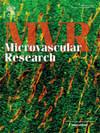Increase in endothelial microparticles is negatively correlated with decrease in renal microperfusion in septic rats
IF 2.7
4区 医学
Q2 PERIPHERAL VASCULAR DISEASE
引用次数: 0
Abstract
Introduction
Endothelial dysfunction is an important pathophysiological mechanism of septic acute kidney injury, and endothelial microparticles (EMPs) can directly reflect the endothelial damage. However, the relationship between EMPs and renal microperfusion remains unclear. In this study, contrast-enhanced ultrasound (CEUS) imaging and side-stream dark field imaging were used to evaluate the renal microcirculatory perfusion in septic rats.
Methods
A cecal ligation and puncture model was established for inducing septic kidney injury in Sprague-Dawley rats. Later, the changes in mean arterial pressure (MAP), lactate level, renal artery blood flow (RBF) and mean renal artery velocity were measured. Flow cytometry was conducted to measure EMPs, CEUS imaging was performed to evaluate cortical and medullary perfusion enhancement, and side-stream dark-field imaging was carried out to detect the perfused small vessel density (PVD) and microvascular flow index of the renal cortex.
Results
In the sepsis group, EMPs and lactate levels increased at 12 h, macrohemodynamics (MAP and RBF) did not change, and the mean artery velocity (547.76 ± 28.40 mm/s) increased compared with the sham group (421.78 ± 34.58 mm/s). Meanwhile, cortical peak echointensity (PE), medullary PE, PVD, and microvascular flow index (MFI) decreased at 12 h. The decreases in pulsatility index (PI) and resistance index (RI) suggested the damage of vascular appearance. The pathological results revealed erythrocyte stasis in the capillaries. At 24 h, macrodynamics decreased compared with that at 12 h. The EMPs and lactate levels reached a peak at 24 h. Glomerular vascular endothelium was locally thickened. Moreover, EMPs were negatively correlated with the decreased renal microcirculatory perfusion.
Conclusions
This study shows that endothelial microparticles (EMPs) are closely associated with renal microcirculatory dysfunction in septic acute kidney injury (S-AKI). CEUS can sensitively reflect changes in renal microperfusion, providing earlier indications of kidney injury compared to macrocirculatory changes, and holds potential for early diagnosis of S-AKI.
内皮微粒的增加与脓毒症大鼠肾微灌注的减少呈负相关。
内皮功能障碍是脓毒性急性肾损伤的重要病理生理机制,内皮微粒(Endothelial microparticles, EMPs)可直接反映内皮损伤情况。然而,EMPs与肾微灌注之间的关系尚不清楚。本研究采用超声造影(CEUS)和侧流暗场成像技术评价脓毒症大鼠肾脏微循环灌注。方法:建立sd - dawley大鼠败血性肾损伤盲肠结扎穿刺模型。测定各组平均动脉压(MAP)、乳酸水平、肾动脉血流量(RBF)和平均肾动脉流速的变化。流式细胞术测量emp,超声造影评估皮质和髓质灌注增强,侧流暗场成像检测肾皮质灌注小血管密度(PVD)和微血管流动指数。结果:脓毒症组EMPs和乳酸水平在12 h时升高,大血流动力学(MAP和RBF)无变化,平均动脉流速(547.76 ± 28.40 mm/s)高于假手术组(421.78 ± 34.58 mm/s)。同时,皮质峰值回波强度(PE)、髓质PE、PVD和微血管血流指数(MFI)在12 h时下降。搏动指数(PI)和阻力指数(RI)下降提示血管外观损伤。病理结果显示毛细血管内红细胞淤积。与12 h相比,24 h时宏观动力学降低。emp和乳酸水平在24 h时达到峰值。肾小球血管内皮局部增厚。EMPs与肾微循环灌注降低呈负相关。结论:本研究表明,在脓毒性急性肾损伤(S-AKI)中,内皮微粒(EMPs)与肾微循环功能障碍密切相关。超声造影能敏感地反映肾脏微灌注的变化,与大循环变化相比,能提供更早的肾损伤指示,具有早期诊断S-AKI的潜力。
本文章由计算机程序翻译,如有差异,请以英文原文为准。
求助全文
约1分钟内获得全文
求助全文
来源期刊

Microvascular research
医学-外周血管病
CiteScore
6.00
自引率
3.20%
发文量
158
审稿时长
43 days
期刊介绍:
Microvascular Research is dedicated to the dissemination of fundamental information related to the microvascular field. Full-length articles presenting the results of original research and brief communications are featured.
Research Areas include:
• Angiogenesis
• Biochemistry
• Bioengineering
• Biomathematics
• Biophysics
• Cancer
• Circulatory homeostasis
• Comparative physiology
• Drug delivery
• Neuropharmacology
• Microvascular pathology
• Rheology
• Tissue Engineering.
 求助内容:
求助内容: 应助结果提醒方式:
应助结果提醒方式:


